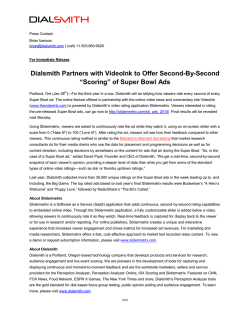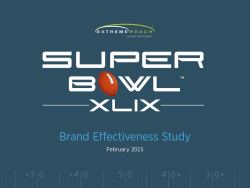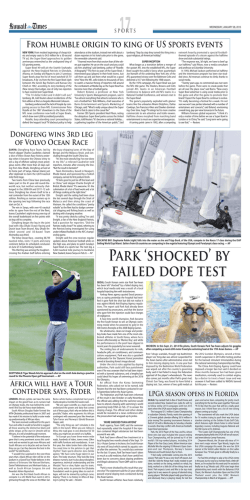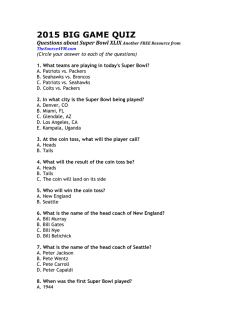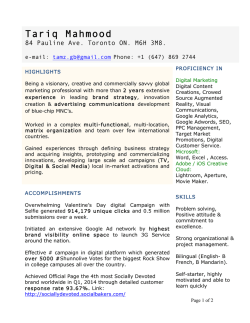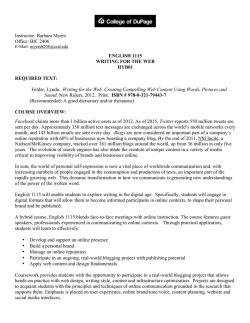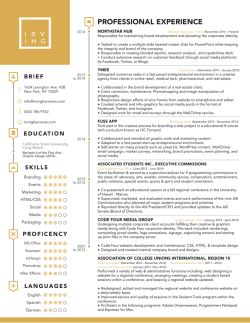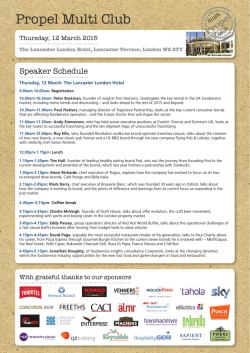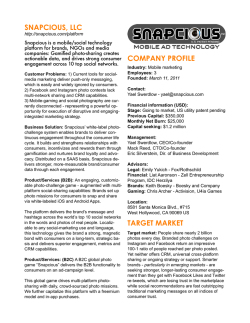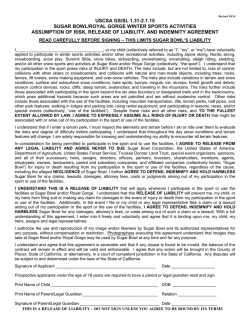
A Quantitative Analysis of Digital Super Bowl Campaigns to
A Quantitative Analysis of Digital Super Bowl Campaigns to Find the Real Winners KEY: #FTW Wix Social SEO Display Paid Search & Email Bud Light Social SEO Display Paid Search & Email Budweiser Social SEO Display Paid Search & Email Doritos Social SEO Display Paid Search & Email Coca-Cola Social SEO Display Paid Search & Email Loctite Social SEO Display Paid Search & Email Mophie Social SEO Display Paid Search & Email McDonald’s Social SEO Display Paid Search & Email Toyota Social SEO Display Paid Search & Email Always Social SEO Display Paid Search & Email #fail Heading into Super Bowl XLIX, it’s arguable which topic got more hype: Super Bowl commercials or deflated footballs. But at the end of the day, advertisers who spent big ad dollars for a prime time spot either saw their investment rewarded, or let a golden opportunity slip through their grasp. The Super Bowl has long been the biggest advertising event of the year, and with over 115 million viewers, it offers advertisers a unique platform for generating brand awareness. In recent years, advertisers have realized they can drive even more value from their investments by incorporating their ad campaigns across channels. Doing so not only increases their exposure, but allows them to engage with users before, after, and during the game. In this report, we evaluate how well advertisers supported their campaigns across the main digital channels – social media, paid search, email, SEO, and display. Read on to see which brands were the big winners and which came up short. SCORE METHODOLOGY Earned Social Points Earned Display Points Earned SEO Points Paid Search & Email Points x 2 x 1 x 1 x 1 Social media is the Super Bowl’s second arena. While the teams face off on the gridiron, brands take to social to capitalize on viewers’ attention to their second screens. The brands who have shelled out the money for an on-air ad need to keep users’ attention to get the most bang for their marketing buck. They also need to out-maneuver brands who haven’t bought a TV spot but have a chance to use social to steal the show. While Facebook and YouTube were poised to take advantage of real-time ad buying during this year’s game, in this study we concentrated on Twitter, as it still provides the biggest playing field for real-time engagement with viewers. We looked at three major categories, on a scale from 0-3: Content, Engagement, and Conversation. Naturally there is overlap in these categories. Chances are if a brand is excelling in one category, they’re likely doing well across the board. How We Scored ENGAGEMENT CONTENT warmed the bench didn’t bother to suit up tossed out calls-to-action, but little strategy is evident cursory content designed primarily around the ad responded to users brand-supporting and game-related content MVP-caliber, responded in a personal and authentic manner real-time responsive content creation, demonstrating investment in agile creative resources CONVERSATION forgot to show up employed an effective hashtag displayed hashtag in the on-air ad, bridging offline and online content actively used the hashtag with game-time content WIX Content Engagement Conversation Wix dominates on the social front. Wix showed up suited and ready to play, bringing best-in-class real-time and ‘on-product’ content. The Super Bowl rookie wasn’t afraid to run with the big dogs – bantering with the big brands and even creating a website on the fly for Doritos, a clear touchdown for its campaign’s tagline #ItsThatEasy. It dominated in the content arena but truly raised the bar in engagement and conversation through its “Easy” contest. Wix successfully leveraged secondscreen user-behavior to infiltrate ad spaces and steal users’ attention – without spending an extra cent in Super Bowl media buys. Wix showed that a classic approach -- staying on-product and on-message -- is still a winning strategy. Loctite Content Engagement Conversation Loctite delivers big engagement in crunch time. Rookie of the year would be an understatement for Loctite – which showed the big brands how social is done. Its clever and focused advertising stood out. A lot of brands were making noise on social but Loctite was actually saying something. The brand’s content had an opinion, it took a side, and it wasn’t afraid to play with the seasoned vets of Super Bowl advertising. Loctite demonstrated a true understanding of social media: it’s about the users. Playing in a space as an unknown, Loctite made it clear that a shiny, tech-heavy social media command center is not a substitute for authentic and personalized engagement. The brand stayed focused, self-aware, and on message with real people in real time. Coca-Cola Content Engagement Conversation Coca-Cola brings positive spin to the social sphere. #MakeItHappy was, in many ways, a return to form for this classic big brand. In 2014, Coke phoned it in with its social and digital campaign, but the brand came back with a stronger playbook this year. Its content strategy took clear aim at second-screen user behavior, challenging users to help Coke take on the Internet’s trolls and haters. But the venerated brand may have bitten off more than it can chew. In the hours after the big game, the brand’s content was beginning to look repetitive and the responses to users more boilerplate. The trick will be to keep the positivity going strong, otherwise #MakeItHappy risks being a flash in the pan. Despite this challenge and a year marked by the rise of newcomers, Coke demonstrated you can still breathe fresh air into your longterm brand story. FUMBLE Snickers & Dove Snickers and Dove fumbled their opportunity to take advantage of the social audience. They had the opportunity for real-time engagement, but blew it when they responded with canned replies or ignored responses to their calls for user-generated content. INTERCEPTION VOLVO Volvo threw down the gauntlet and proved you can use other brands’ ad spend to the benefit of your own marketing. Getting users to turn away from competitors’ on-air spots to engage with its brand – genius. Wix also gets a shout-out for playing in this space as well. Pass interference McDonalD’s McDonald’s showed up with a savvy contest on social, effectively leveraging every other advertisers’ TV spots for the Golden Arches’ gain. Kudos for the clever sneak attack, and the positive messaging to complement the brand’s recent marketing pivot. But McD’s could have done more to stick the landing. The brand fell short in paid search, display and SEO. BRANDWATCH WEIGHS IN Adam Bambrough Brandwatch | Vice President, Indirect Revenues Will McInnes Brandwatch | CMO Last year, we declared Super Bowl newcomer Jaguar the winner in digital marketing. Ahead of the game, the brand vaunted their real-time social media capabilities, and indeed they were ready. We reached out to someone who was in Jaguar’s social media “war room” last year, Adam Bambrough, VP at Brandwatch. We wanted to get his take on social’s role during the Super Bowl, from real-time execution to the post-game analysis. Will McInnes, Brandwatch’s CMO, also joined us. What do you see as the biggest opportunity for brands that take to social during the Super Bowl? AB | Social represents a fantastic opportunity for brands to show their ‘human’ side, hunker down on the couch alongside friends, beers and dips, and genuinely connect with, and become part of, a great shared experience. Whilst traditional TV spots can tug at heartstrings, play to patriotism or wow with spectacle, a successful Social Super Bowl outing is more likely to have playfulness, wit, and an ‘edge’ in it’s DNA, and most importantly be - literally - ‘in the moment’. It’s Realtime or bust. Generally, what do you see as the biggest missed opportunity? AB | Whilst the last few years have seen brands upping their game in both valuing & delivering quality, cutting real-time content, there is still an opportunity in sheer scale of direct consumer engagement during the game. I enjoyed working onsite on game day last year with the Mindshare and the Spark44 team to support Jaguar’s first Super Bowl ad, where we enabled a Social Command Center to power smart and sophisticated engagement at scale, and the content and engagement level led the class. I’d also like to see some clever social/physical participation hacking. Perhaps from an integration with wearable fitness device… Social can be a way to level the playing field, pardon the pun. The brands that have shelled out the money for an on-air ad need to keep users’ attention. But brands that haven’t bought a TV BRANDWATCH WEIGHS IN spot have an opportunity to steal the show (JCPenney’s mitten tweet last year, for example). What is the biggest challenge for sponsors to keep users’ attention and fend-off social guerrilla marketing to make their on-air investment worthwhile? WM | Attention is scarce. Attention moves around. Attention is fickle. The biggest challenge is earning it, and we all know that. Sponsors take the direct route. They buy airtime. They buy space. It’s a sure fire play. Kind of. In the end, it’s a war of creativity. The most engaging ads still engage - they elicit tears, they provoke laughter. But the most engaging tweets can grab attention away from those ads. Research shows, in fact, that much engagement happens at ad breaks. So advertisers have to employ their best creative weapons. They have to be proactive. They have to support their costly ad turf with brilliant, witty Twitter air cover. And the single best way to make their investment worthwhile? Back the creative. Let’s talk post-game. How can sponsors keep up the momentum from their Big Game campaigns, and parlay that into their marketing mix for the rest of the year? WM | Some people suggest that we’ve moved to an always on model. It feels like we have, so the way we talk to CMOs is to see the creative challenge of a Super Bowl or other big event as a platform to prototype and road test new approaches. Ideas with legs. So it’s about designing ideas that can scale. And then being open-minded - seeing what happens, rolling with the unexpected, and if you find a fair wind, then harnessing it for as long as it blows. Simple really! About Brandwatch Brandwatch is one of the world’s leading social intelligence companies. Its social media listening and analytics technology platforms gather millions of online conversations every day and provides users with the tools to analyze them, empowering brands and agencies to make smarter, data-driven business decisions. Prime placement in the organic results of search engines is key to absorbing interest from viewers before, during and after the game. While social profiles may rank well for certain advertisers, an optimized landing page that is integrated with a brand’s domain will have the greatest benefit for organic search acquisition, visibility, and long-term gains. In order to assess the Super Bowl advertisers’ organic search, we analyzed brands based on the following 6 criteria: HOW WE SCORED Landing Page Creation Mobile Optimized no campaign specific landing page was created landing page was not mobile optimized landing page created, but not on brand domain landing page was partially mobile optimized landing page existed on brand domain landing page was fully mobile optimized Discoverability Quality Backlinks landing page was not organically discoverable landing page received no backlinks landing page was discoverable but for a limited number of queries or poorly ranking landing page received minimal backlinks landing page was easily discoverable and ranks well Landing Page Optimization landing page was not optimized for organic search at all landing page had some on page elements optimized landing page had optimized on-page elements and additional, related content landing page received multiple quality backlinks Searchable content in commercial the commercial did not contain any searchable content The commercial contained limited searchable content (e.g. hashtag) the commercial contained multiple pieces of searchable content (typically the landing page URL and a hashtag) The brands that scored particularly well not only had a strong, optimized page that ranked well, but the on-page content married their Super Bowl campaign with their brand’s unique identity and product offering. WIX Landing Page Creation Discoverability COMMERCIAL Optimization Mobile Optimized Backlinks Searchable Content Wix brings home the SEO crown. Wix created an optimized landing page not only for its Super Bowl commercial, but also unique websites for past NFL players’ “companies,” which were featured in their ad. The player “company” websites were individually designed to portray the scope of Wix’s product offering, and were complete with game- and campaign-specific content. Wix rolled out the #ItsThatEasy campaign before the game, allowing them to rank for Super Bowl- related searches and garner backlinks. During and after the game Wix updated its landing page to encourage individuals to take part in fun contests, as well as vote for the brand in YouTube’s AdBlitz favorite commercial contest. On all fronts, Wix seamlessly incorporated search into its overall marketing strategy. BUD LIGHT Landing Page Creation Discoverability COMMERCIAL Optimization Mobile Optimized Backlinks Searchable Content Bud Light builds strong organic presence for ‘Up for Whatever’ campaign. Bud Light’s branded landing page was fully optimized to organically rank for both Super Bowl and campaignrelated searches. As a sequel to last year, the brand continued its ‘Up for Whatever’ campaign and used recycled content in the form of user-generated Instagram posts. Bud Light organized the images into categories to provide visitors an easy way to explore, helping to build backlinks on the Bud Light domain and increase the site’s strength. DORITOS Landing Page Creation Discoverability COMMERCIAL Optimization Mobile Optimized Backlinks Searchable Content Doritos sets itself up for future success with “Crash the Super Bowl” landing page. With Doritos’ “Crash the Super Bowl” campaign, user-submitted commercials were hosted on the Doritos domain where visitors could view and rate their favorite videos. The brand’s landing page was optimized for mobile and integrated with its social channels. Additionally, by not including the year or Super Bowl number in its URL, Doritos is giving itself the opportunity to reuse the landing page to garner new links over time – further benefitting the site in the long run. Overall, the brand positioned itself well to capture online traffic and keep its audience engaged. It was tough to narrow the criteria we wanted to evaluate in trying to understand which brands rocked display advertising during the Big Game. As with the display possibilities during any period of time, there are a lot of different facets: desktop vs. mobile, video vs. static banners, engagement ads, social cross-over…the list goes on. Regardless of the specific tactic or medium, brands had an opportunity to use display to engage with users before, during, and after the game. Brands who pre-released their ads can drive future value from their campaigns by setting up a strategy to target users who watched their videos online or visited any Super Bowl-related pages on their site. Getting insight into which users were engaging with their ads required ground work before kick off by placing tags so the brand can target those users later. HOW WE SCORED Display partner pixels Youtube left your tags out of the game not a video to be found having a pixel on the home page teased commercial ahead of the game having a pixel on the landing page included a related link in the description OR displayed a companion banner Real time ad Buys no real time engagement included a related link in the description AND displayed a companion banner purchased premium spots on top sports sites (e.g., espn.com, nbcsports.com, etc.) during the game ad creative complemented the Super Bowl ad In the days & weeks after, we’ll see if we keep getting blasted with banners, but for now, we’re looking to see who is prepped and ready with a solid strategy to be used down the line in their display efforts. BUDWEISER & BUD LIGHT BUDWEISER Display Partner Pixels YouTube Real Time Ad Buys BUD LIGHT Display Partner Pixels YouTube Real Time Ad Buys Budweiser & Bud Light go above and beyond with display ads. Budweiser and Bud Light went big in display, creating commercial-related landing pages that were tagged with various tracking pixels that could be used for retargeting later. Their commercials were pre-loaded to YouTube and both brands purchased numerous display spots on prominent sports websites during the game. Additionally, they took some extra steps we weren’t expecting, including running pre-roll ads on videos returned for YouTube searches of “[brand] super bowl ad,” as well as getting a promoted spot on the YouTube homepage below the section for Super Bowl game highlights from the NFL. Mercedes Display Partner Pixels YouTube Real Time Ad Buys Mercedes’ display efforts support “The Big Race.” Mercedes created a Super Bowlcommercial landing page fully loaded with tracking tags, and also placed the Google Retargeting Tag on its YouTube Page, which will allow it to retarget users who view its ad or subscribe to its page. Similar to Budweiser, Mercedes was capitalizing on the extra traffic to YouTube’s homepage by setting up a promoted placement spot that features 5 of its channel’s videos below the top Super Bowl clips. Toyota Display Partner Pixels YouTube Real Time Ad Buys Toyota buys premium inventory to reinforce ‘Bold’ message. Toyota had a pair of commercials: “How Great I Am,” which was released on YouTube over a week ago, and “My Bold Dad,” which was released during the Super Bowl. Both videos were extremely well-integrated with Toyota’s social media efforts (#OneBoldChoice) with links to Facebook, Twitter, Instagram, and Google+ in addition to two links back to Toyota’s YouTube channel and website. Toyota’s website has over two dozen advertising tags that will enable the brand to reach and retarget users far and wide. To reinforce its bold Super Bowl commercials, Toyota also purchased premium display advertising inventory such as on NBC’s live stream. #FAIL T-MOBILE Display Partner Pixels YouTube Real Time Ad Buys T-Mobile cut themselves off at the knees in display. In its #KimsDataStash Super Bowl commercial on YouTube, instead of sending users to http://kimsdatastash.com, the link in its video description goes to the brand’s “data stash” page, which features a different marketing character: “Data Vulture.” And T-Mobile banner ads that co-triggered during its #KimsDataStash commercial on the NBC live stream had users land on the brand’s “WiFi calling” page – featuring Chelsea Handler and Sarah Silverman! By failing to send users to relevant pages, T-Mobile prevented themselves from closing the loop. Paid search offers advertisers the chance to steal visibility on relevant queries and control messaging. Brands can take charge of their SERP presence by paying for ads on searches for their brand or related non-brand queries. With control over ad copy messaging and landing pages, advertisers have the opportunity to use paid search to define the brand image and experience they’re promoting to searchers. While this marketing tactic is not a stage for creative expression or community development, paid search is key to curating searchers’ experience with your brand. A well-coordinated approach means closing the gap between an interested viewer and an interactive site visitor. HOW WE SCORED Paid ads for relevant keywords Landing Page no paid presence on relevant keywords totally unrelated to the Super Bowl some presence on relevant terms great reinforcement of television ad left a couple of keywords wide open total keyword coverage Ad Copy MOBILE failed to extend paid presence to phones took up paid space for mobile users ignored the big game connected the paid search ad to the television commercial BONUS exceptional use of paid search or boneheaded mistakes email Email is at the intersection of scale, control, addressability, and speed. It is one of the most effective ways to personalize communication with an existing customer base. Some advertisers took advantage of this direct line to their customers with ads that hyped up their fans with strong calls to action, coupons for game day snacks, and exciting contests. Merkle | RKG kept email scoring simple and only reviewed whether advertisers were hyping up the crowds with Super Bowl-related email content or if they dropped the ball this year. WIX Paid Ads for Relevant Keywords Ad Copy Landing Page Mobile Exceptional Email Wix achieves high visibility through a varied keyword list and robust ad unit. Website builder Wix matched its customizable platform with some fully-customized paid listings. The advertiser prioritized strong keyword coverage to capture all interested Super Bowl searchers. Not only were the brand’s ads showing, but each ad was curated to match the variety of queries on which it was advertising. Each of Wix’s four ‘AllPro websites’ was paired with a unique search ad, with fun sitelinks, hashtags from their Super Bowl campaign and relevant callout extensions that took up additional real estate on search result pages. The targeted approach and varied keyword list kept the brand in the conversation. This is how it’s done folks. Loctite Paid Ads for Relevant Keywords Ad Copy Landing Page Mobile Exceptional Email Loctite sticks it to the Competition. Loctite is the MVP, Mobile Visible Player, for Super Bowl XLIX with its aggressive mobile branding strategy. Because many of the big players were not fully utilizing their brand terms in paid search, Loctite took advantage of that weakness and bid up on other brands’ terms. This tactic allowed Loctite to cover much of the mobile playing field. #WinAtMobile BUDWEISER & BUD LIGHT for both brands: Paid Ads for Relevant Keywords Ad Copy Landing Page Mobile Exceptional Email Budweiser and Bud Light offered similarly well-structured and eyecatching ads. Bud is a seasoned Super Bowl vet, and the brand’s solid paid search effort showed that an old Clydesdale can still play in the digital space. Hashtags were carried over from TV to create noticeable ad headlines, while keyword coverage was strong for all three of the Anheuser-Busch spots. Email Shout-Outs Microsoft, Pepsi and Coke gave customers coupons for their all-important snackage for the Big Game. The Buds (Budweiser and Bud Light) were heavy email hitters, with previews of ad content, related contests, and social media shenanigans starting long before the coin toss. Microsoft Bud Light Budweiser Interceptions Interceptions were happening across the SERPs leading up to the Big Game, as Super Bowl advertisers stole the top spots from competitors. And the big advertisers weren’t the only brands benefitting from their commercials this year – competitors and even unrelated advertisers cashed in on Super Bowl hype. As an advertiser, Lexus already had skin in the game, but in the week before the Super Bowl, the brand pushed competitors out by showing ads on BMW and Mercedes-Benz searches. On occasion, Lexus even outranked its competitors on their own brands. Boom! INTERCEPTIONS YouTube capitalized on commercialrelated Super Bowl terms with links to related (and some not-so-related) advertisers videos. Searching for Doritos? Try this Mazda CX-5 instead. Toyota beat Doritos at its own game by pushing in on self-proclaimed “steal the super bowl” advertiser’s brand searchers. Steal back your SERP presence, Doritos! While there were plenty of great digital campaigns planned and executed with the same diligence as the television commercials themselves, the Digital Bowl came down to a battle between a seasoned veteran and a Super Bowl advertising newcomer: Wix Wix did all the little digital things you’d hope for from a company that deals in website hosting. With a great paid search and organic search strategy implemented prior to the big game, Wix was ready to capture searchers looking for relevant content. Taking home the crown for both the paid search and SEO categories is an impressive accomplishment, and shows Wix knew how valuable the SERP can be to a winning strategy. Wix didn’t stop there. With great social content, engagement, and conversation throughout the game, Wix took the top spot in the social category as well. The brand’s impressive efforts to keep up with social users in real time – despite the huge time zone gap – really set Wix apart. Bud Light This wasn’t Bud Light’s first rodeo, and the brand executed solid strategy across the board. Recycling user-generated Instagram posts helped lay the groundwork for a solid organic presence, and Bud Light locked down its SERP presence with focused ads that included its social hashtags in the copy, pushing users for additional engagement. Where Bud Light really excelled was in its excellent use of Display marketing, running pre-roll ads on Super Bowl commercials found on YouTube and locking up a promoted spot on the YouTube homepage. Bud Light iced the cake with premium display inventory buys across the web during the game to stay in front of users on their secondscreen in real-time. Conclusion The Winner Despite Bud Light’s phenomenal showing in the display space and strong presence on the SERP in both paid and organic, Wix brought a digital edge that saw it turn in the top performance in paid search, organic search, and social, highlighting just how good the Super Bowl newcomer was across the board. That’s why Wix is taking home the Super Bowl XLIX Digital Bowl crown – and it wasn’t close. Top Performers Wix’ victory marks the second year a newcomer topped the field in optimizing for digital visibility before, during and after the game, capitalizing on the online spillover of interest. With Super Bowl ads accounting for such a huge investment, it’s clear that those advertisers dipping their toes into these pricey waters for the first time have done well to capitalize on this big spend over the past couple of years. At the same time, veteran advertisers are realizing the online impact of their ads and optimizing accordingly, as shown by Budweiser, Doritos, and Coca-Cola rounding out the top five in the Digital Bowl, in that order. While Doritos brought the best organic optimization of the three, they failed to fully take advantage of the SERP as their paid ads didn’t trigger as often as they should have, a space where Budweiser excelled. After that it was Loctite, Mophie, McDonald’s, Toyota and Always rounding out the top ten. Though Loctite accompanied their hilarious television creative with a solid social game, including witty interactions with other advertisers, the glue-company-turned-Super-Bowl-advertiser fumbled in display and SEO. This is a trend we saw across several Super Bowl advertising rookies: they knew how to engage their audience socially, but failed to capitalize in other areas. Always put forth a strong campaign in everything but paid search, where it was a complete no-show. Project Leaders: Dalton Dorné George Kamide Social Media: Dalton Dorné George Kamide Liz Mongan Ruchi Parikh SEO: David August Jake Haskins Samiul Huque Rachel Lam Chase Lyne Ryan Ottino Dave Thomas Milton Welch Paid Search & Email: Elaine Lichtman Laura Scott Jonathan Unger Writing & Publishing: Heather Cave Mallory McClenathen Andy Taylor Display: Michelle Alfano Kearby Chen Design: Sarah Courtney Glenn Merkle | RKG is a search and digital marketing agency that combines superior marketing talent with world-class digital media capabilities to create the industry’s most effective data-driven digital marketing solutions. Merkle | RKG drives business to clients by maximizing a full range of opportunities including paid search, SEO, product listing ads, social media, display advertising, and comparison shopping engine management services. Merkle | RKG is part of Merkle (merkleinc.com), the largest privately-held customer relationship marketing agency in the nation. Merkle | RKG is headquartered in Charlottesville, VA with offices in Bend, OR and Boston, MA. For more information, visit MerkleRKG.com or follow @MerkleRKG on Twitter.
© Copyright 2026
